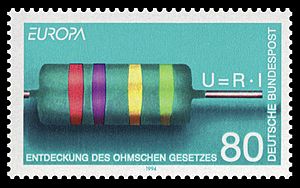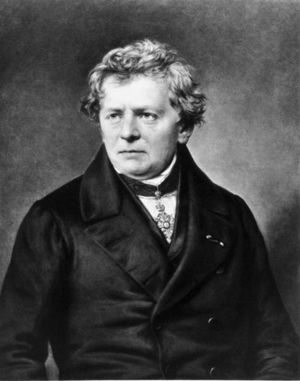Georg Simon Ohm facts for kids

Georg Simon Ohm (born March 16, 1789 – died July 6, 1854) was an important German physicist and mathematician. For some time, he worked as a school teacher. Ohm spent part of his life studying the new electrochemical cell. This special battery was invented by the Italian scientist Alessandro Volta.
Using tools he built himself, Ohm discovered a key rule about electricity. He found that the voltage (or "push") across a wire is directly related to the electric current (the flow of electricity) through it. This important relationship is now called Ohm's law. Years after he passed away, in 1881, the international unit for electrical resistance was named "Ohm" in his honor. The Greek letter Omega (Ω) is used to show this unit.
Who Was Georg Simon Ohm?
Georg Simon Ohm was born in Erlangen, Germany. His father was a locksmith, but he was also very smart and taught his children a lot. Georg went to the University of Erlangen-Nuremberg. He studied mathematics, physics, and philosophy.
After finishing his studies, Ohm became a teacher. He taught at different schools, including a high school in Cologne. It was during his time as a teacher that he started doing his most famous experiments with electricity.
Discovering Ohm's Law
Ohm was very interested in how electricity moves through different materials. He used wires of various lengths and thicknesses. He also used the new electrochemical cell to create an electric current.
Ohm carefully measured the voltage and electric current. He noticed a pattern: if you increase the voltage, the current also increases in a predictable way. This discovery showed a clear link between voltage, current, and something called electrical resistance. Resistance is how much a material tries to stop the flow of electricity.
His famous law, Ohm's law, can be written as:
- Current = Voltage / Resistance
This means that if you have more voltage, you get more current. But if you have more resistance, you get less current. This law is still used every day by engineers and scientists around the world.
The Ohm Unit
Because of his groundbreaking work, the international community honored Georg Simon Ohm. They named the unit of electrical resistance after him. This unit is called the "Ohm."
When you see a light bulb or an electronic device, it has a certain amount of resistance. This resistance is measured in Ohms. For example, a resistor might have a resistance of 100 Ohms. The symbol for Ohm is the Greek letter Omega (Ω). This is a lasting tribute to a brilliant scientist who helped us understand electricity much better.
Images for kids
-
A memorial for Ohm by Wilhelm von Rümann at the Technical University of Munich.
See also
 In Spanish: Georg Simon Ohm para niños
In Spanish: Georg Simon Ohm para niños



